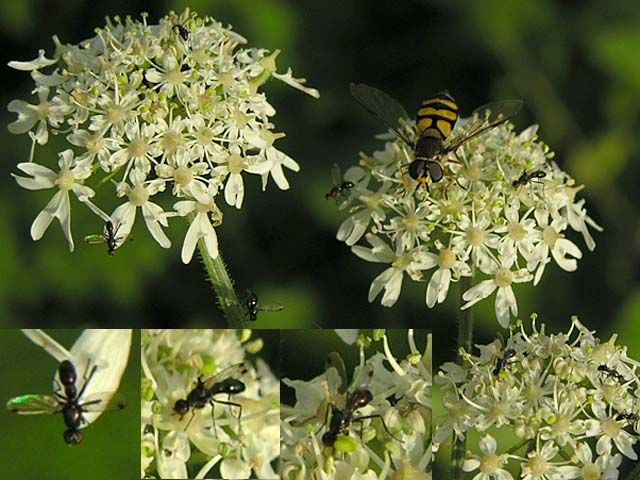Thread subject: Diptera.info :: Didea Fasciata and little friends(?)
Posted by Robert Heemskerk on 25-10-2005 23:00
#1
Dear Fly-friends,
On the 4th of October/Amstelveen I saw this Didea fasciata (female) sitting on a flower with a lot of little flies. Very tiny little flies with black spots in the wings. Does anyone know what kind of flies these are? (family-name = fine for me)
Best regards, Robert Heemskerk

Edited by Robert Heemskerk on 29-10-2005 20:23
Posted by Xespok on 26-10-2005 04:17
#2
This looks like a Sepsidae fly (possibly Sepsis sp) to me, but others will probably corect if I am wrong.
Posted by Paul Beuk on 26-10-2005 06:15
#3
No need to correct. You are spot on (pun intended).
Posted by Robert Heemskerk on 26-10-2005 14:41
#4
Thanks a lot!
In Dutch you call them 'Wenkvliegjes' I think..
And that means that these little flies sway's (swings?) with their wings.
regards, Robert Heemskerk:p
Edited by Robert Heemskerk on 26-10-2005 14:42
Posted by Nikita Vikhrev on 26-10-2005 19:57
#5
I found the English name for this "gymnast wing moving". This "gymnastic" is very usual for flies from Sepsidae, Opomyzidae, Pallopteridae as far as I observed. It is rather strange as all 3 are from different superfamilies. On the other hand I've never seen "gymnast" wing moving of Dryomyzidae or Sciomyzidae from the same superfamily as Sepsidae.
I didn't find yet any explanation of this neither in books nor here in Diptera.info
Posted by Nikita Vikhrev on 27-10-2005 11:23
#6
Right today I met Andrey Ozerov (one of the best world specilist for Sepsidae) and put him this question. His answer was - mating behaivor. Reasonable.
Pro this explanation is that all Sepsidae, Opppomyzidae ect have more or less spoted wings. To move spotted wings is the best way to show your size both to female or another male. But it is for my oppinion still unclear what is first and what is secondary - wing moving or spotted wing.
Contre it is that, it seems to me, that I've seen wing-moved females too.
Posted by Jan Willem on 27-10-2005 15:02
#7
Hi Nikita,
Very interesting, continue your investigation!
Jan Willem
Posted by Nikita Vikhrev on 27-10-2005 16:58
#8
Well Jan, than I have a question to you.
In case of Odonata some species is territorial, some (even closely related) - not.
Oppomyzidae and Pallopteridae are territorial?
Posted by Jan Willem on 28-10-2005 06:50
#9
Hi Nikita,
I have never heart of territorial behaviour in the families Pallopteraidae and Opomyzidae, and never witnessed territorial behaviour in the field. However that doesn't mean it doesnot occur since my field experience is rather limited. I have seen the wing moving behaviour in species of the genus
Geomyza but never got the impression the males used this behaviour towards eachother. I should spend more time next you on studying this behaviour!
Jan Willem
Posted by Nikita Vikhrev on 28-10-2005 08:46
#10
Than, what do we have "en somme".
1. Andrey Ozerov with rich field experience confirm that Sepsidae is territorial and he has seen several times that two male show each other wings, than one of them go out, another one left.
2. I (with modest field experience) have seen several times flies from all this families moving wings as well during fiding, in absence of another fly, bieng female.
3. Nobody else know answer so far, as everybody keep silence.
Posted by Louis Boumans on 29-10-2005 19:23
#11
With respect to Tephritidae i have come across two other explanations of wing swaying (all these expl do not exclude each other):
- spreading of pheromones into the air
- deterring jumping spiders. These spiders themselves have stripes on their front legs which they sway in mating behaviour.
i don't have the refs at hand now, but i'll see if can look sth up later. VCheers, Louis
Posted by Louis Boumans on 30-10-2005 19:02
#12
Greene et al. 1987
A Tephritid fly mimics the territorial displays of its jumping spider predators. Science 236:310-312.
Of course this cannot be the explanation for all waving ~ swaying behaviour in flies (even apart from flight ;-), but I thought it's sth nice to have heard of.. Louis
Posted by Nikita Vikhrev on 30-10-2005 19:17
#13
Both mating behaivor and jumping sprider's mimic according with the essential fact that all this unrelated flies have both spoted wings and wing swaying. And that groups with generaly clean wings show no wing swaying.
Mating behaivor seems explanation with more weight.
But "spriders" explain the presens of wing swaying in females and during any "non mating" situation.
Nikita
